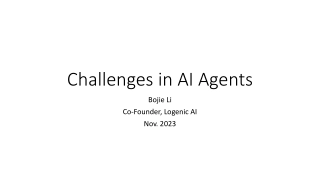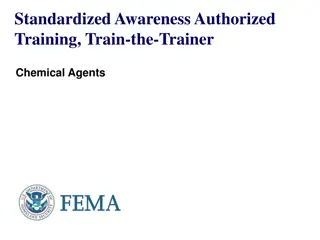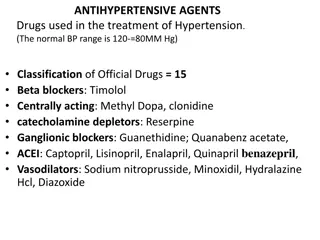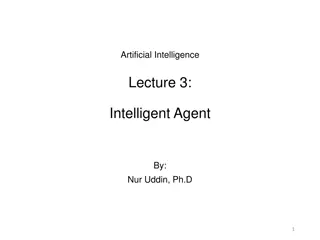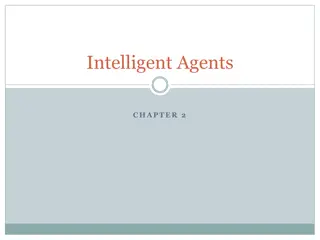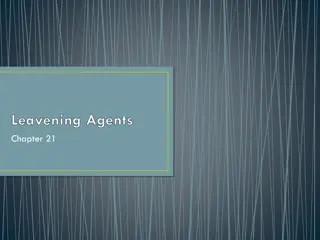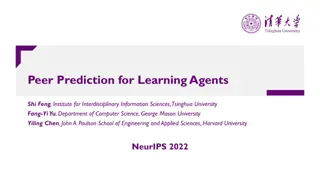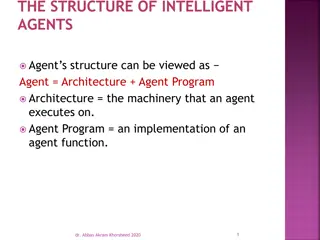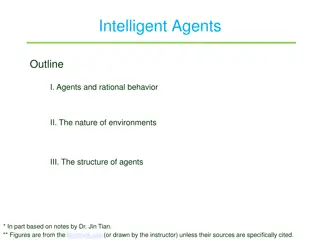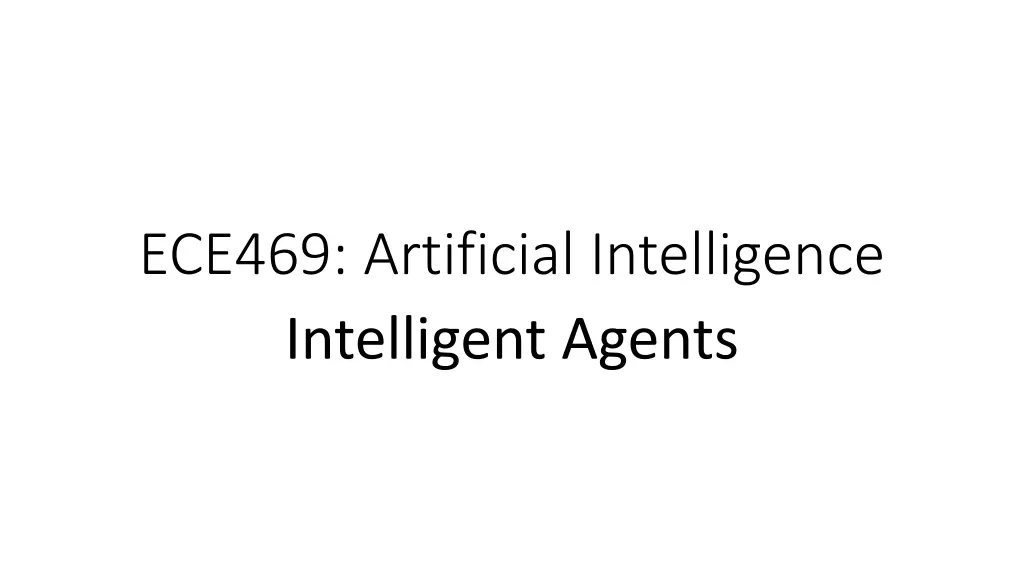
Understanding Intelligent Agents in Artificial Intelligence
Explore the concept of intelligent agents in artificial intelligence, including definitions, agent functions, rational agents, and the vacuum-cleaner world. Learn about the role of percept sequences and how agents make decisions based on prior knowledge and environmental inputs.
Download Presentation

Please find below an Image/Link to download the presentation.
The content on the website is provided AS IS for your information and personal use only. It may not be sold, licensed, or shared on other websites without obtaining consent from the author. If you encounter any issues during the download, it is possible that the publisher has removed the file from their server.
You are allowed to download the files provided on this website for personal or commercial use, subject to the condition that they are used lawfully. All files are the property of their respective owners.
The content on the website is provided AS IS for your information and personal use only. It may not be sold, licensed, or shared on other websites without obtaining consent from the author.
E N D
Presentation Transcript
ECE469: Artificial Intelligence Intelligent Agents
Agents Book: "An agent is anything that can be viewed as perceiving its environment through sensors and acting upon that environment through actuators" A percept is an agent's perceptual inputs at any given instant A percept sequence is the complete history of percepts An agent's choice of action can depend on the entire percept sequence, plus whatever prior knowledge the agent had An agent's behavior can be described by an agent function mapping the percept sequence to an action Given any agent function, you can imagine a large (possibly infinite) table describing it I add: Two possible caveats are agents that sometimes perform random actions and agents operating in non-discrete environments An agent program implements the agent function
Vacuum-cleaner Agent The next slide depicts a simple version of a vacuum-cleaner world in which a vacuum- cleaner agent might exist One simple agent function for such an agent (which could be described with a table) is: If the current square is dirty, clean it Otherwise, move to the other square This might be rational under certain assumptions, but not otherwise (it depends, at least, on the performance measure) Performing actions in order to modify future percepts is called information gathering; e.g., looking both ways before crossing the street A related concept is exploration; e.g., if the vacuum-cleaner agent's initial environment is unknown, it can start off moving around to create a map The definition of a rational agent (which we discuss shortly) requires an agent to learn as much as possible from what it perceives
Rational Agents Book: "A rational agent is one that does the right thing" (but what that means is not always obvious) A performance measure is used to evaluate agents It is better to design a performance measure according to what you want in an environment rather than how you think an agent should behave For example, for the vacuum cleaner agent, it is better to evaluate it based on having a clean floor as opposed to how much dirt it cleans What is rational at a given instant depends on four things: The performance measure The agent's prior knowledge of the environment The percept sequence The allowable actions Definition of a rational agent: "For each possible percept sequence, a rational agent should select an action that is expected to maximize its performance measure, given the evidence provided by the percept sequence and whatever built-in knowledge the agent has."
Task Environments According to the textbook, task environments "are essentially the problems to which rational agents are the solutions" A task environment includes the performance measure, the environment, the agent's actuators, and the agent's sensors (PEAS) The book uses an automated taxi driver as an example of a complex agent and discusses its task environment The environment consists of roads, traffic, pedestrians, customers, potholes, weather, etc. The actuators include the steering mechanism, the accelerator, the break, signals, the horn, displays, etc. The sensors might include cameras, sonar, a speedometer, GPS, an odometer, engine sensors, a keyboard or other input devices, etc. The performance measure may depend on safety, speed, legality, comfort of trip, friendliness, maximization of profits, etc.
Categorizing Task Environments Task environments can be categorized along the following dimensions Fully observable versus partially observable Deterministic versus stochastic (versus strategic) The 4thedition of the textbook changes the term "stochastic" to "nondeterministic", and says they only use "stochastic" when explicit probabilities are used; However, other places, they revert to "stochastic" The 4thedition also drops the term "strategic", but I think this distinction is very important The book points out that in many real-world situations, deterministic but partially observable environments often must be treated as stochastic; whether they are really deterministic is a moot point Episodic versus sequential Static versus dynamic (versus semidynamic) Discrete versus continuous Single-agent versus multi-agent (other agents can be cooperative, competitive, or mixed) Known versus unknown (strictly speaking, this is not a property of the task environment, but rather the agent's knowledge of it) The figure on the next slide shows how various task environments can be categorized, but some of these labels are debatable
Types of agents Types of agents: Simple reflex agents Each action depends only on the current percept Actions can be based on a lookup table or determined by simple rules; randomness is allowed Model-based reflex agents These agents keep track of parts of the world they observe to handle partially observable environments They maintain an internal state (e.g., a map) Such agents can rely on a transition model (indicating how the world works and how actions affect the environment) and a sensor model (indicating how percepts indicate the state of the world) Goal-based agents These agents have goals describing desirable situations; search and planning are used to achieve goal Even when they perform the same actions as a reflex agent, the reasoning is philosophically different Utility-based agents These agents have a utility function that maps a state (or sequence of states) to a number indicating an associated degree of "happiness" Note that goals are binary; they are either achieved or not achieved Agents can either use hard-coded rules to make decisions, or they can learn the rules
Agent Representations Types of agent representations (related to expressivity or complexity): Atomic representations - each state of the world is indivisible Factored representations - each state is comprised of a fixed set of variables, or attributes, each of which has a value Structured representations - each state includes a set of objects and their relationships that can be described A more expressive representation can capture everything that a less expressive one can plus more We can also distinguish between localist representations and distributed representations A localist representation means that there is a one-to-one mapping between concepts and memory locations (e.g., in a computer or a brain) A distributed representation means that each concept is spread over multiple locations A local representation could be more error prone (e.g., if a few bits are garbled); distributed representations may be more robust

